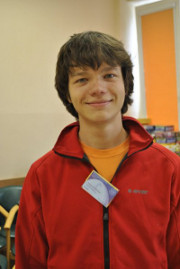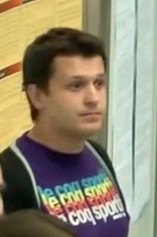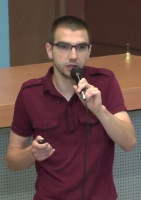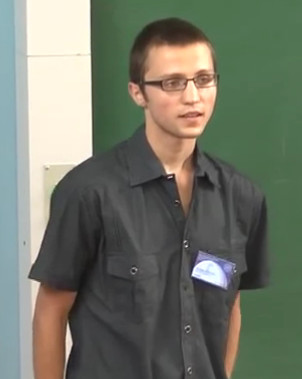15th International Workshop
for Young Mathematicians
"Functional Analysis"
Gilles Cassier
Université de Lyon I
Dilation curve associated with an operator and its applications
Dilation theory has been particularly successful in the study of contractions acting on a Hilbert space H. The aim of this lecture is to associate a dilation curve with any operator T in B(H), to give properties of this curve and its applications in several areas of operator theory. We show how it allows us to make a Julia analysis and a Harnack ordering for operators. This dilation curve also intervenes into estimates for hyperbolic metric and could be used more generally to obtain sharpened inequalities involving operators. In particular, we give optimal estimates for the norm ||f(T1)X − Xf(T2)|| where T1, T2 and X are three operators in B(H) and f belongs to special function classes.
Conference talk
Unfortunately due to some technical problems this lecture's video is incomplete:
Piotr Niemiec
Uniwersytet Jagielloński
Certain aspects of functional calculus for bounded normal operators
For a bounded normal operator N and a bounded Borel function f:σ(N) → C one defines f(N) as the integral ∫σ(N) f(t) dEN(t) where EN is the spectral measure of N. Using the functional calculus defined above, many classical properties of scalar functions (such as being a monotone, convex, Lipschitz or Hölder function) are transferred into the operator context. For example, a (Borel) function u:∆ → R (where ∆ ⊂ R is an interval) is operator monotone iff for any two bounded selfadjoint operators A and B acting on a common Hilbert space, whose spectra are contained in ∆ one has u(A) ⩽ u(B). There is a fascinating theorem due to Loewner which fully characterizes all operator monotone functions. The talk will be devoted to the proof of Loewner’s theorem based on Choquet’s simplices. If time permits, some information on operator Hölder and operator Lipschitz functions will be given. Surprisingly, these two similar classes totally differ in their operator versions.
Conference talk
Piotr Sołtan
Uniwersytet Warszawski
Kwantowe rodziny odwzorowań
Przedstawię podstawy tak zwanej nieprzemiennej topologii, czyli dziedziny
zajmującej się badaniem "przestrzeni kwantowych", tj. obiektów kategorii
dwoistej do kategorii (być może nieprzemiennych) C*-algebr. Podkategoria
obiektów dwoistych do przemiennych C*-algebr odpowiada dokładnie lokalnie
zwartym przestrzeniom z odwzorowaniami ciągłymi jako morfizmami. W tym
kontekście wprowadzę pojęcie ciągłej kwantowej rodziny odwzorowań. Omówię
problem istnienia kwantowej przestrzeni wszystkich odwzorowań z jednej
przestrzeni kwantowej do drugiej i pokażę, że jeśli taka przestrzeń istnieje,
to posiada bogatą strukturę "półgrupy kwantowej". Przedstawię kilka przykładów
takich obiektów.
Conference talk
Franciszek H. Szafraniec
Uniwersytet Jagielloński
Thirty years of unbounded subnormality in Kraków
Conference talk
Ryszard Szwarc
Uniwersytet Wrocławski i Uniwersytet Opolski
Orthogonal polynomials and symmetric linear operators
Orthogonal polynomials show up in many areas of modern mathematics.
Some of them are eigenfunctions of differential operators. Some other play
a role of matrix coefficients of representations of matrix groups. General
orthogonal polynomials are always associated with special symmetric linear
operators called Jacobi matrices. These matrices can be either bounded or
unbounded.
The aim of the lecture is to give introduction to orthogonal polynomials
and show connections to Jacobi matrices. I expect the audience is familiar
with basic theory of bounded linear operators. Some elements of the theory
of unbounded operators will be used as well, and explained on-line if necessary.
Conference talk
Laszlo Zsido
Università degli Studi di Roma "Tor Vergata"
Operator theoretical methods for dynamical systems
Endre Szemerédi has proved in 1974 that any set of natural numbers having strictly positive upper Banach density contains arithmetic progressions of arbitrary length (the Erdös-Turán conjecture). His proof is combinatorial and works via a graph-theoretic problem.
In 1977 Hillel Furstenberg proved a multiple recurrence theorem for transformations preserving a probability measure, which implies Szemerédi’s theorem. Part of Furstenberg’s results holds also in the framework of dynamical systems on general operator algebras.
I intend to discuss the operator theoretical methods involved in the investigation of multiple recurrence properties of dynamical systems on operator algebras with final land on Szemerédi’s theorem.
Conference talk
Krzysztof Drachal
Politechnika Warszawska
Simplicity and depth of the Banach fixed-point theorem
A simple proof of the Banach fixed-point theorem is presented. Then it is presented how the theorem can be applied to generating pictures (i.e. in fractal compression). Moreover a bit of information about fractals is given. Finally a little (non-obvious) digression and considerations are presented how fractals describe Nature.
Conference talk
Dariusz Dudzik
Politechnika Krakowska
Kakutani - Markov fixed point theorem
In Topology and Functional Analysis, there are many fixed point theorems (the most famous among them are the fixed point theorems of Banach, Brouwer, and Schauder). They are often very nontrivial and useful. In the talk I will present some versions, proofs and applications of the Markov - Kakutani (simultaneous) fixed point theorem, whose standard statement reads as follows. Let K be a nonempty compact convex subset of a locally convex space. Then every commuting family of continuous affine maps of K into itself has a common fixed point.
Conference talk
Mikołaj Frączyk
Uniwersytet Jagielloński
Structure of point spectra of bounded linear operators on Banach space
We will pressent few facts concerning structure of point spectra of bounded linear operators on a Banach space. Among other things, the result that in reflexive spaces they always are Fσ, and in Hilbert spaces these are exactly Fσ sets.
Conference talk
Joanna Garbulińska
Uniwersytet Jana Kochanowskiego w Kielcach i Uniwersytet Jagielloński
On the Gurarii space
Gurarii space is a separable Banach space G satisfying the following condition:
(*) Given finite-dimensional Banach spaces X ⊆ Y, given ε > 0,
given an isometric embedding f: X → G there exists an injective linear operator
g: Y → G extending f and satisfying |g|·|g-1| ≤ 1 + ε.
This space was found by Gurarii in 1966. Its uniqueness up to isometry was proved
by Lusky in 1976. We shall present a category-theoretic description of the Gurarii space, obtaining simpler proofs of some known properties of this space.
Conference talk
Lecturer did not agree to show conference video.
Zofia Grabowiecka
Uniwersytet w Białymstoku
Spectral radius of weighted composition operators
We will present a variational rinciple due to A. B. Antonevich and A. V. Lebedev which expresses the spectral radius of weighted composition operators
(aTf)(x)=a(x)f((x)), f ∈ F(X),
acting in various function spaces F(X). Moreover we will explain equivalence of this result with a similar formula obtained independently by A. Kitover for spectral radius of weighted automorphism of the function algebra C(X). This motivates an abstract C*-algebraic approach to the theory of the operators under consideration.
Conference talk
Tomasz Kołodziejski

Uniwersytet Jagielloński
Geometry of Banach spaces - Rodé's theorem
I'll present some basic theorems of Banach Space Geometry escpecially Rodé's theorem concerning weak* closure of convex compact set. Main tool used in proof will be the Bischop-Phelps theorem which we will also proof during talk.
Conference talk
Kamil Kular
Uniwersytet Jagielloński
Remarks about derivations on Banach algebras
Consider the following famous conjectures about derivations on Banach algebras:(C1) every derivation on a Banach algebra has a nilpotent separating ideal,
(C2) every derivation on a semiprime Banach algebra is continuous,
(C3) every derivation on a prime Banach algebra is continuous,
(C4) every derivation on a Banach algebra leaves each primitive ideal invariant.
Conjectures (C1), (C2) and (C3) are still open, even in the case of commutative Banach algebras. Assertion (C4) is usually referred to as the noncommutative Singer-Wermer conjecture. It is true in the commutative case. We will present some remarks about relations between these conjectures.
Conference talk
Mateusz Łącki
Uniwersytet Jagielloński
Spectral analysis of 1D complex quantum systems through Matrix Product States
The standard way to analyze a broad class of complex 1D quantum system in physics
is so called Density Matrix Renormalization Group (DMRG). This is a family of effective
numerical techniques. A natural representation of such a system arises within DMRG:
it is so called Matrix Product States (MPS) representation. It has a large potential
for mathematical research. However, not much of investigation by mathematicians
was performed neither for DMRG, nor for MPS. I my talk I will give a brief review
of physical background (what are quantum complex systems), mathematics of MPS
(I will try to summarize all of the research done for MPS so far, including some statements about when can we describe quantum complex systems by DMRG/MPS efficiently). In the last part I will present my results on application of MPS to perform a spectral analysis of a complex quantum system. I would like to include detailed results in a poster (supplement to a talk).
Conference talk
Przemysław Mazur
University of Cambridge
Compact groups and Hilbert's fifth problem
The fifth problem on the famous list of 23 mathematical questions published in 1900 by David Hilbert was the following (roughly speaking): if a topological group is locally homeomorphic to a Euclidean space, is it necessarily diffeomorphic to this space? The case of compact groups was solved by John von Neumann in 1933 using Peter-Weyl theorem. During the talk we will see the proof of the result of Peter and Weyl by studying the structure of compact self-adjoint operators acting on a Hilbert space. We will also sketch the rest of the proof given by von Neumann and mention how this result becomes a foundation of Fourier analysis in more general setting.
Conference talk
Magdalena Nowak
Uniwersytet Śląski
Application of the Hahn-Banach theorem in welfare economics
The lecture will deal with applications of the Hahn-Banach theorem in welfare economics, a branch of mathematical economics that focuses on how the optimal allocation of resources affects social welfare. We will present the second fundamental theorem of welfare economics and its proof.
Conference talk
Piotr Pokora

Politechnika Krakowska
Linear Maps on Operator Spaces Preserving Spectrum and Numerical Range
Let us denote by H a complex Hilbert space. We will consider the following operator spaces:
- B(H) is the complex linear space of all bounded operators on H,
- H(H) is the real linear space of all self-adjoint bounded operators on H,
- BK(H) is the complex linear space of all operators on H which have the form α idH + K, where α is a scalar coefficient and K is a compact operator,
- HK(H) = BK(H) cap H(H) (it is a real linear space).
We denote by σ(X) the spectrum of an operator X in B(H), and define the numerical range of X by W(X) = {<Xv,v> : v ∈ H, <v,v> = 1}, where <⋅,-> is the inner product on H.
The main goal of the talk is to present a proof (based on the original paper) of the following theorem [1].
Theorem 1. [Chi-Kwong Li, Rodman, v Semrl]
Let V be one of the above operator spaces and let ε: V→V be a surjective linear map. Then the following conditions are equivalent
(1) ε maps the set of self-adjoint elements into itself, and σ(ε(X)) = σ(X) for all self-adjoint X in V,
(2) ε is continuous (in the norm topology), maps the set of self-adjoint elements into itself, and is such that σ(ε(X)) = σ(X) for all orthogonal projections X in V,
(3) W(ε(X)) = W(X) for all X in V,
(4) W(ε(X)) = W(X) for all X in V,
(5) there is a unitary operator U in B(H) such that varphi is of the form X ↦ UXU* or X ↦ UXtU*, where Xt is the transpose of X with respect to some fixed orthonormal basis in H.
At the end of the talk we will present a generalization of the theorem [2].
The bibliography:
[1] Chi-Kwong Li, L. Rodman, P. v Semrl, Linear Maps on Selfadjoint Operators. Preserving Invertibility, Positive Definiteness, Numerical Range, Canad. Math. Bull. 46 (2): 216-228 (2003).
[2] S. Clark, Chi-Kwong Li, J. Mahle, L. Rodman, Linear Preservers of Higher Rank Numerical Ranges and Radii, Linear Multilinear Algebra 57 (5): 503-521 (2009).
Conference talk
Łukasz Rzepnicki

Uniwersytet Mikołaja Kopernika
Riesz-spectral operators
The operator A is called a Riesz-spectral operator if it possesses a Riesz basis consisting of eigenvectors (a Riesz basis is some generalization of the orthonormal basis),
the corresponding eigenvalues are all simple, and the spectrum is totally disconnected. Riesz-spectral operators are connected with many problems in partial differential equations. They also have quite simple representation and allow nice characterizations of many properties such as generation of C0 semigroup, invariant subspaces, exponential stability. In this talk basic facts concerning Riesz basis and properties of Riesz-spectral operators with some examples will be presented.
References
[1] R. F. Curtain, H. J. Zwart. An Introduction to Infinite Dimensional Linear Systems Theory. Springer, New York, 1995.
[2] I. C. Gohberg, M. G. Krein. Introduction to the Theory of Linear Non- selfadjoint Operators in Hilbert Space. American Mathematical Society, Providence, 1969.
[3] B.Z. Guo, H. J. Zwart. Riesz Spectral Systems. Memorandum No. 1594 , Faculty of Mathematical Science,University of Twente, November 2001.
Conference talk
Michał Świętek

Uniwersytet Jagielloński
A note on Gowers' Dichotomy theorem
The following question was asked in Banach's book Théorie des opérations linéaires:
is l2 the only infinite-dimensional Banach space (up to isomorphic) which is isomorphic
to all its infinite-dimensional subspaces? During the lecture I will present an important
special case of Gowers' dichotomy theorem, which together with the Komorowski and
Tomczak-Jaegermann's theorem, gives a positive answer to above question and thus a new isomorphic characterization of separable Hilbert spaces. Dichotomy theorem, whose proof is based on application of Ramsey theory to Banach spaces, is wonderful illustration of permeation of mathematical branches, which are not as remote from each other as they seem to be and thus confirm us in its inner coherence.
Conference talk
Elwira Wawreniuk
Uniwersytet w Białymstoku
Convex conjugate of the spectral exponent of analytic functions of weighted composition operators
This is joint results with K. Zajkowski. We derive a relationship between the Legendre-Fenchel transform of the spectral exponent of weighted composition operators acting in Lp-spaces and the Legendre-Fenchel transform obtained for their analytic functions. We establish the variational principle for the spectral exponent of analytic functions of weighted composition operators.
Conference talk
- » Home Page
- » News
- » Information
- » About the Workshop
- » Rules
- » Lectures summary
- » Sponsors
- » Book of abstracts
- » About Cracow
- » History
- » Contact
| LATEST NEWS |
|
Video recordings from lectures held at the XV Workshop
Thursday, 4 October 2012 Report on 15th Workshop Wednesday, 18 July 2012  polska wersja polska wersja
|